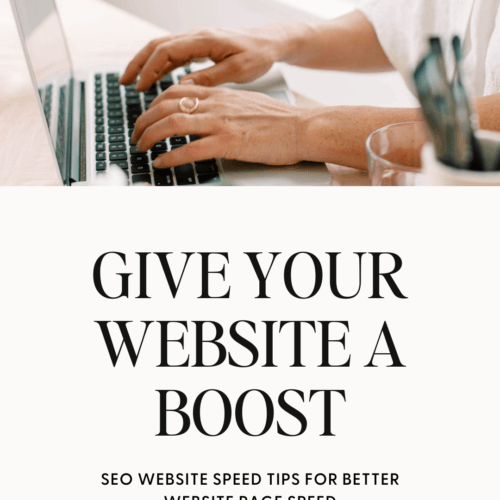Did you know that keyword research and on-page SEO are only one piece of the SEO optimization puzzle? Site speed is one of the most important factors in overall website success, affecting everything from visitor engagement to Google rankings! In this post, we’ll talk about honing in on SEO website speeds, how to check your website page speeds, and what you can do to make improvements.
What are website page speeds?
Website page speeds are simply a measurement of the amount of time it takes to load a specific page whenever someone clicks through to your website. Site speed, on the other hand, is the average loading time of your entire website.
Does SEO affect website speed?
Yes and no. Following SEO practices on your website by including on-page elements like targeted keywords, and relevant image names, and alt text does not affect your website speed. I highly recommend installing an SEO-boosting plugin to help optimize each post and page of your website. My pick is Rank Math – it’s user-friendly and displays key stats like how many times you’ve shown up in search results, which keywords you’re ranking for, and how many clicks your site is getting.
While Rank Math and on-page SEO won’t slow down (or speed up) your site, following best off-page SEO practices will affect your website speed! Optimizing the back end of your website includes auditing your website for the fastest loading speeds possible.
How page speed affects SEO
Even though it might not be the first thing you think of when it comes to SEO optimization, loading speed is a direct ranking factor for Google. In other words, Google’s algorithm is checking your site’s speed just as much as it’s combing through your site for keywords and relevant, search-worthy information.
Indirectly, page speeds also affect your search engine ratings by decreasing user bounce rates and increasing session times. The faster your site loads, the less likely it is that people will click away without viewing anything. Faster loading speeds encourage people to stick around on your website for longer, browsing more pages as they go. All that time spent by users tells Google that your site is relevant and helpful to visitors, and your site will climb higher and higher in search rankings.
Why is site speed important in SEO?
Google search result rankings are a little bit like a secret recipe – they’re a complex mix of things, and we don’t know every single ingredient Google uses in their formula. However, they do give designers and developers guidelines and best practices to go on as we create websites. So, while we don’t know exactly how Google evaluates each website, we do know that they prefer websites with a good user experience. And one of the most important parts of a positive user experience is website speed.
People expect your website to load in three seconds or less. While that might sound incredibly fast, it’s actually a long time to sit around waiting for a website to load! No matter how many keywords you’ve used, how scroll-stopping your design is, or how much conversion strategy you’ve packed into your website, users are more likely to click the back button if the site is slow to load.

How fast does my website need to be?
As fast as possible! As of 2023, the average page loading time is 2.5 seconds on desktop and 8.6 seconds on mobile. However, Google prefers load times of less than half a second. 🤯 The faster your website loading times, the better!
How to check your website page speed
My go-to for checking website page speeds is Google Page Speed Insights. All you have to do is enter your URL; then, Google will analyze your current site and assign a performance score. Be sure to tab over from “mobile” to “desktop” to get the full picture of your site performance!

Page Speed Insights also provides helpful reports on which parts of your site could be improved to boost your grade. The ideal score is at least 90, but if you’re not there yet, that’s OK! I’ll walk you through some speed boosters below.

Side note: Insights automatically gives you a ton of recommendations when evaluating your website, and the language might be confusing. Don’t worry! Keep reading for some practical, easy steps that will boost your score and resolve some of the most common issues.
How can I increase my website speed with SEO?
It’s all about auditing your site to figure out what’s already working, pinpoint the problems, and make sure your site is running as well as it can be! Here are some of the most common areas of improvement I see on my client’s websites:
Hosting makes a difference
Hosting is where all the files that make up your website “live” on the internet, and the type of hosting and the provider you choose directly affect your website’s speed! Whenever someone types your URL into their browser, your hosting provider sends data to their computer so they can view your website. Having a more dependable, faster-hosting provider means that your website and pages load quicker for visitors. My top picks are Flywheel and Kinsta.
Check your plugins and themes
While themes and plugins are incredibly useful tools and exist on most WordPress websites, they can also clog up website speeds. An easy fix is to double check that you don’t have any old, inactive plugins or themes installed on your site. Even if you’re not using them anymore, they still take up space on your site and can slow things down. Uninstall anything you’re not using to speed things up!
Install NitroPack
You’ll get suggestions on changes you can make that will include loading times. Start with the free version to get a feel for how it works, then upgrade to paid for access to comprehensive suggestions and ongoing optimization.
Use code: SOUTHERNCREATIVECO for a discount!
Optimize photos
In most cases, raw or original image files are much higher quality than what’s needed for images to display properly on your website. They’re also data-rich files that take longer to load, slowing your entire website down. Use the Tiny Compress Images or EWWW Optimizer plugins to optimize existing website images, then use TinyPNG or RedKetchup on any new images before you add them to your site.
Avoid hosting video or audio directly on your site
Instead, host them on another service like YouTube or Vimeo, then embed them into your website. Even if you host video and audio content elsewhere, be mindful not to overload your site with long-form content! Keep clips as short as possible and replace them with static images for mobile.
Minimize dynamic elements
Anything that’s constantly changing or moving on your site is a “dynamic element.” Video backgrounds, gifs, Instagram feeds, and countdown clocks are all fabulous ways to personalize your website and add eye-catching graphics, but they can also increase loading speeds! Choose dynamic elements wisely, periodically evaluate their impact on loading speed, and switch them out for static images on the mobile version of your site.
Install a full website caching/optimization plugin
Every time your site loads on a visitor’s computer, the files that make up your site have to be sent to them by your host servers. A browser caching plugin helps users’ browsers temporarily store some of your site’s information on their own computers so it will load faster each time they visit or as they click through your site.
If you’ve already installed NitroPack and have managed hosting from Flywheel or Kinsta, then you’re good to go! These services are compatible with one another and should work together seamlessly.
Pro tip: The techy details of caching plugins can be tricky, so always double-check compatibility between your hosting provider and plugin of choice and follow any additional directions provided by those services. You can check NitroPack’s hosting compatibility here. If NitroPack isn’t the one for you, consider WP Super Cache or W3 Total Cache as backup options!
Don’t skip mobile optimization
The desktop version of your site isn’t set up to display quickly or correctly on phones, so it’s crucial to set up a version of your site for mobile viewing. Over 60% of organic search result visits come from mobile devices, so make sure you’re ready for both desktop and mobile visitors!
Want clarity and confidence that your SEO website speeds are lightning-fast?
Contact us for a WordPress website audit! We’ll review your website’s loading speeds and tech and provide an easy step-by-step guide of next steps.
More of a DIYer – we’ve got something for you too! Download our Free Website Audit Guide!






